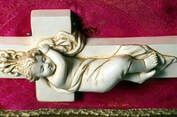
Last Sunday we began to put our crib up in the church. At the moment it’s just an empty space waiting to be filled, which is a good image for ourselves during this season of Advent, as we try to unclutter our lives a bit from all that needs to be done at this time of the year, and create a space within ourselves to welcome Christ. Our crib in St. Mungo’s is fairly simple, which I think is what most people prefer. I remember some years ago, when I was parish priest at Mount Argus in Dublin, we caused quite a stir by doing something different with the crib. At the time there was a lot of media coverage around the number of people sleeping rough in shop doorways, on makeshift beds, made out of cardboard boxes. A local artist, a member of our parish, designed a crib made out of cardboard boxes to create a link between these poor people, and Mary and Joseph, who were homeless at that first Christmas, finding nowhere to stay, and eventually giving birth to their child in a cave cum stable behind an inn. The reaction was extraordinary. Many people got the link and were deeply moved, and greatly challenged by it. Other people saw this as an insult to Mary, Joseph and Jesus, and protested vehemently. At the very least it raised a debate and, while we didn’t repeat it after, returning to a more traditional crib, I believe to this day that it was well worth the doing.
I was recalling too, during the time I was novice master in North Europe, that I had to attend a meeting in Bavaria during Advent. I think the temperatures were well below zero, down around minus twenty. The Passionists in Bavaria were extremely welcoming and, on one of the days, during a break in the meetings, I was brought by one of the priests to the town of Bamberg, which is apparently known as the Nativity Town. It is, in fact, a UNESCO World heritage listed town and, throughout the city you’ll find an extraordinary collection of nativity scenes. I was brought by my colleague to a place called the Krippenmuseum. This museum belongs to a man who developed an obsession with nativity scenes at an early age, and has been collecting ever since, from all over the world, reflecting every country and culture you could think of, made out of every material imaginable, as well as designing his own Nativity scenes. It was an amazing experience. I think our cardboard box crib may have fitted in well.
We, Passionists, also have quite a unique take on the crib. Saint Paul of the Cross, our founder, often spoke about a link between Bethlehem and Calvary, the Crib and the Cross. When he would build the Crib each Christmas at Monte Argentario, the very first Passionist foundation in Italy, and the place where, during Advent 1982, I had the privilege of making a retreat to prepare for my diaconal ordination, Paul would place a cross behind the child in the Crib to remind those who would pray there of the true meaning of Christmas: “for us and for our salvation he came down from heaven”. As with our cardboard crib, such a take on the Nativity can help rescue us from an overly sentimental approach to Christmas, because we realise that even in the poor stable at Bethlehem, where a homeless family birthed their first child, the love of God is revealed as a sacrificial love, a love that lays down its life. I was delighted to discover that this tradition, begun by our founder almost 300 years ago, had continued down the years.
We haven’t put our crib up at the Passionist Community house in Bishopbriggs yet. We tend to wait until Advent turns around on December 17th when the liturgy, from focussing towards the future coming of Christ, starts to prepare us to celebrate His first coming. We are all well.
As ever, protect yourself, your loved ones and others, and protect Christ in your lives.

 RSS Feed
RSS Feed
